American Sabbatical 020: 9/25/96
St. Labre
9/25.. Into Montana.
Now we’re camped on the campus of a Catholic High School on the Cheyenne Reservation. We rode
the interstate down the Yellowstone Valley..actually UP the Yellowstone
valley.. to Miles City. Coming out of North Dakota the land boils
up into great grassy mounds, and the range is bronzed among the
sagebrush. Is this from the red soil we see exposed underneath,
or a touch of frost? In any event it adds another hue to the prairie
palette.
|
Black cattle against bright white wheatstraw. Lone windmills cranking
by greywood corrals and out buildings. Solitary oil pumps dipping
and spinning slowly in their nests of tanks. Frowning black buttes
on the edge of things suddenly shining in sunlight..and that hallelujah
sky. |
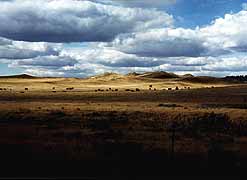
Cattle
|
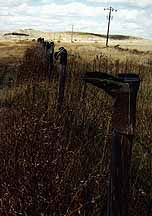
Boots
|
Hard to be moody all day. Especially when the class clowns keep
making faces. Yesterday it was a big old kitchen stove on the
roadside with its door torn off. The sign said “OPEN RANGE”. Today
it was a barbedwire fencerow. On top of every post was an upturned
cowboy boot. Some snazzy ones, I might add. |
| And the friendly folks help a lot, too. We’ve yet to come face
to frown with a hostile Westerner..although the occasional sheriff
has given us the long eyeball. In Miles City we were ready to
settle down and buy property. The place felt like Brunswick...
low key, upbeat, friendly, and jovial... Brunswick after Labor
Day, that is. |
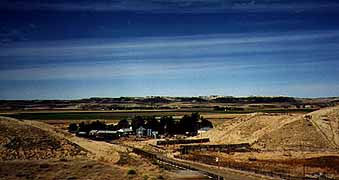
Montana Ranch
|
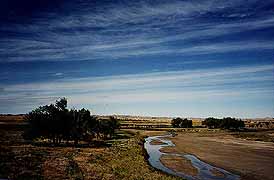
September River
|
We splurged. I bought a $3 vest in the thrift, and Peggy spent
$5 for earrings in the pawn. (Maybe it is The Resonance again,
Miles City was the big cowboy town on the northern range in the
1870’s and 80’s, where many a dusty dollar was spent freely.) |
We got so nervous at the big spending, we had to rush out onto
the backroads south to get away from the bright lights. No problem
now, the only light here is the moon, and it’s smutching over.
The weather prophecy on the CW station (we’re listening to nothing
but shitkickin music, honey) calls for snow showers tonight in
eastern Montana. But camp we must, cause the motel ambiance is
smothering.. whiny dial tones and all. We’ll try to mail this
via Cheyenne phone lines tomorrow.
(Memo # 20)
Sept. 26 - St. Labre Mission School
Northern Cheyenne Reservation, Montana
Who? Catholic Missionaries (Father Emmett Hoffman), Cheyenne and
Crow Tribes
What? St. Labre Mission School
Where? northern Cheyenne Reservation, south central Montana
When? school established in 1884
How? church support, private donors, tribal involvement
Topics: Crow Tribe, Cheyenne Tribe, St. Labre, Mission schools,
Native American education, multicultural education.
|
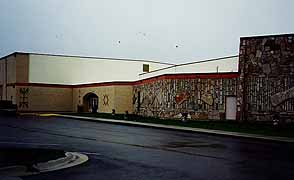
St. Labre School
|
|
Questions: What is a school on a Native American Reservation like?
How could / how should education be different for Native Americans?
How could / how should education be different for any ethnic group? |
|
Listeners may wonder how we choose our route on our travels. It
is a mixture of interest and research and tips and serendipity.
Both of us have a list of places all over the United States we’ve
always wanted to see - for me the list included Seneca Falls,
Hull House, the Theodore Roosevelt ranch. Bryce has a different
t list - the American Bottom, the Oregon Trail, South Pass. Friends
give us suggestions as do people we meet - this morning a trucker
in a small cafe in Ashland, Montana, said we HAD to go to the
museum in Cody, Wyoming. OK, we may. We also consult maps and
travel guides and the brochures we find at rest stops and motels.
It was a Montana tourist magazine that brought us to St. Labre
School in Ashland, Montana, and its excellent small museum.
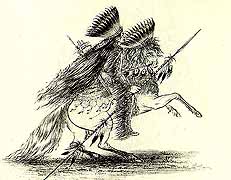
Crow Chief (Catlin - 1830s)
|
St. Labre is a mission school on the Northern Cheyenne Reservation
established in 1884. It has a small wonderful museum, a Catholic
church of very unusual design and over 700 students in four schools
(K-12). The major campus has grown from one log schoolhouse to
a complex of beautiful buildings that unite Native American symbols
with modern buildings. The halls and classrooms are very much
like Freeport High (the halls are carpeted!). I am sending this
message from the high school computer lab adjacent to the library.
Both are slightly smaller than Freeport’s but just as modern.
I noticed flags and pictures that show the Native American heritage
and there is a stuffed buffalo head in one hallway! St. Labre
has housing for staff and a dormitory for the fifty or so students
who board (more boarded in the past).
|
St. Labre is entirely funded through contributions. Its recent
growth is due to the work of Father Emmett Hoffman who has devoted
his life to the school and people of the area. He is only the
second white to be honored by the tribe with a Native American
name (“Soaring Eagle”) and inclusion in the tribal council.
| St. Labre offers very much the curriculum we have at Freeport.
The elementary school uses a whole language approach. The high
school has both a full college preparatory and vocational curricula
with the emphasis on providing every student with a strong academic
foundation. Class sizes are small. They have a technology-based
math program with a computer for every two math students and advanced
courses in both math and science. They have a writing lab. Because
it is a church school, St. Labre has theology courses with integration
of native American spirituality. It also takes responsibility
for teaching the heritage of the Crow and Cheyenne people. There
is a cultural specialist on staff and courses are offered in Plains
Indian Culture, traditional drumming and singing. Seniors are
required to take a course that deals with contemporary issues
and tribal government in the past and present. Health issues critical
to Native Americans are included in courses. |
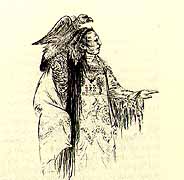
Two Crows (Catlin)
|
When we arrived yesterday, the football team was practicing out
on the field. St. Labre just added a beautiful swimming pool.
Team sports include golf, football, basketball, volleyball, wrestling,
track. Track is spurred by the model of Bill Mills a local man
who won the 10,000 gold medal at the 1964 Olympics, the first
Native American to win a medal.
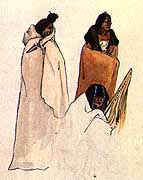
Crow Men (Bodmer)
|
The school provides many community services and has taken responsibility
for economic growth, health, family problems. There is a sawmill
close by and a manufacturing plant was built on the reservation
which makes dental braces components. Poverty and hunger were
real problems when the mission was first established and meals
were a key service.
Dr. Ross Alexander, the school Director with whom I spoke, said
there is some concern that the Cheyenne language is being lost.
Crow students are usually bilingual. Spanish is offered to all
students as well. |
The school is a beautiful modern facility. Most graduates go on
to colleges in the area. I did ask about the possibility of linking
schools. Dr. Alexander says that many places ask for pen pals
and they can’t really do that. So I asked what Maine and Montana
could exchange. Lobsters for elk? He smiles. Any ideas ?
| “St. Labre is unique. We believe in education as social justice
and that every child deserves a superior education. We believe
that education changes lives. At St. Labre, the finest resources,
a sense of commitment and professional expertise come together
to assure a quality education for the students we serve. I invite
you to join us as we strive for excellence.” Dr. Russ Alexander |
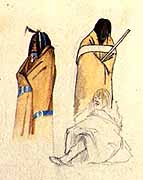
Crow Men (1834)
|
9/26.. St. Labre.
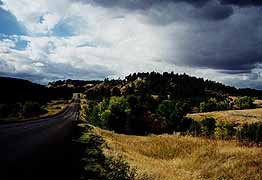
More Black Hills
|
Yesterday, riding the range west into Montana, we swooped up into another Custer Forest (National).. more black
hills.. ponderosa pine and juniper black.. and swung off into
a national campground. Lovely open grove of pines with sandy grasses
shining against cinnamon red shale. But it was early, the ground
was bony and unlevel (fussy.. fussy), and a chill breeze reminded
us that the radio prophets a thousand miles away were giving chances
of snow. So we downhilled it into the naked prairie town of Ashland. |
| Peggy went into the Cheyenne Museum and chatted up the staff while
I roamed the campus of the Catholic school it’s on. Gorgeous architecture.
At the center is a towering tetrahedron.. a huge three-sided triangle,
looking like the mother lodge of the plains tribes, from the top
of which juts out a massive cross. It said to me that Christ is
the lodgepole. This, and all the buildings are faced in native
stone, and on the large pieces are carved native tales. Also inlaid
in the stonework of classroom buildings, etc, are traditional
Cheyenne pictographs.. and one building has large triangular motifs
inlaid which look like an encampment. |
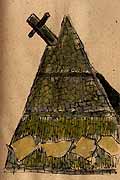
St. Labre Church
(Bryce)
|
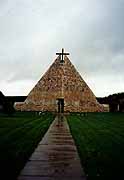
Converging Streams
|
I was standing sketching the big chapel when a native priest stopped,
introduced himself, and invited me in to see inside the church.
It soars, and the feeling is of an immense teepee. Three courses
of stained-glass lights draw an arrow of light and color from
floor to ceiling, and the space is filled with Catholic and Native
symbolism. Stations of the cross carved in plains pictography
on inset sandstone plaques, a crucified Dog Soldier (those who
stake themselves down as after-guard) on a plumed staff. The Father
told me that the school and the church strive to unify the two
traditions, although “some of the old timers object.” He told
me that the cross on the building was leaning because the congregation
was carrying it. The sense of spirit rivers flowing together in
harmony was very strong all around the campus. |
| Peggy was smitten by the school as a vibrant and healthy community,
and when one of the teachers she met suggested we camp on campus
we jumped at the chance to stay on. Two nights in Super8 and we
were begging for fresh air and Coleman cooking. Well it was fresh
enough. Cold as a nun’s.. well, perhaps another simile would be
more courteous. We bundled up and watched the full moon rise over
football practice, while we shoveled in halfcooked latkes. |
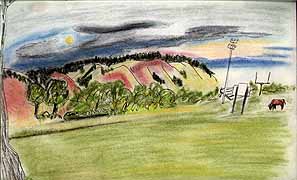
Peggy's St. Labre
|
Then Peggy brushed her teeth with bengay. She managed to spit
it all out, but I got the stomach ache. Wicked stabbing all night,
while she tossed and complained of the cold. By morning we had
all our clothes on, hats and all. Like the good old days in Jonesport.
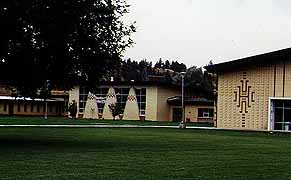
Campus View
|
Then it rained. Blew and rained. By daylight we were ready to
make a break for Festiva. Haggard, holloweyed, and half-sodden
we limped to the local restaurant where we hunkered over steamy
hot mugs of boiled western water-and-additives until school opened.
Peggy made contact with the headmaster and the computer teacher
(also social studies and Spanish, he is), in hopes of maintaining
a connection with this extraordinary institution.. and shipped
our e-mail. |
Then we moved on, grateful for kind hospitality, but not wanting
to overstay. It sounds like they have more visitors than they
need.













